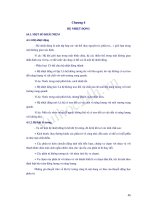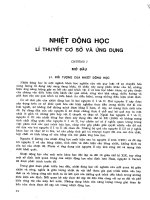nhiệt động học, nguyên lý ETROPY, định lý 2 NDHs
Bạn đang xem bản rút gọn của tài liệu. Xem và tải ngay bản đầy đủ của tài liệu tại đây (296.93 KB, 14 trang )
ENTROPY –
LAW OF
THERMODYNAMICS
ND
2
OUTLINE
• Reversible Process vs Irreversible Process
• Quasi-Static vs Quick Process
• Carnot’s theorem
• Clausius’s Integration
• Entropy
• The Principle of Increase of Entropy
• The Change in Entropy of an Ideal Gas
REVERSIBLE – IRREVERSIBLE
PROCESS
In a reversible process, the system can be returned to its initial conditions
along the same path on a PV diagram, and every point along this path is an
equilibrium state.
A process that does not satisfy these requirements is irreversible.
P
P
1
1
Quasi–static
process
irreversible Quick (sudden) process
2
2
irreversible
reversible
V
V
QUASI-STATIC vs QUICK PROCES
P
P
1
Quasi–static
process
1
Quick (sudden) process
2
2
irreversible
reversible
V
V
Carnot's theorem
Carnot's theorem, developed in 1824 by Nicolas Léonard Sadi Carnot, also
called Carnot's rule, is a principle that specifies limits on the maximum
efficiency any heat engine can obtain.
Carnot's theorem states:
• All heat engines between two heat reservoirs are less efficient than
a Carnot heat engine operating between the same reservoirs.
• Every Carnot heat engine between a pair of heat reservoirs is equally
efficient, regardless of the working substance employed or the operation
details.
Tc
emax eCarnot 1
Th
CARNOT ENGINE
Two reservoirs,
temperature Th, Tc
e ecarnot
Q'
T
1 c 1 c
Qh
Th
Q'
T
c c
Qh
Th
Qc
Q
h
Tc
Th
Qh Qc
0
Th
Tc
CLAUSIUS’S INEGALITY
Qj,
Tj
P
Divide any reversible cycle into a
series of thin Carnot cycles, where
the isothermal processes are
infinitesimally short:
Qi, Ti
V
reversiblecycle
Qi
0
T irriversiblecycle
i
i
reversiblecycle
0
T
irriversible cycle
Q
ENTROPY
reversiblecycle
0
T
irriversible cycle
Q
Consider a reversible cycle 1a2b1
The Clausius integration has sign “=“
P
1
Q
a
2
b
1a 2b1
1a 2
V
Definition: We define a
state variable S that the
change in the entropy dS
is equal to the heat
received in a reversible
process divided by the
absolute temperature of
the system
1a 2
T
Q
T
Q
T
0
Q
T
2b1
Q
2b1
Q
1a 2 _ rever
T
S
0
T
1b 2 _ rever.
Q
12 _ reversible
dS
Qrev.
T
T
Q
T
ENTROPY (Cont.)
Consider an irreversible cycle
1a2: irreversible
2b1: reversible
The Clausius integration has sign “<“
P
1
a
2
b
V
S
12
Q reversible_ process
T irreversible _ process
Q reversible_ cycle
T 0 irreversible _ cycle
Q
0
T
1a 2b1 _ irrev.
Q
Q
T T 0
1a 2irrev.
2b1 _ rev.
Q
Q
T T
1a 2irr.
2b1rev.
Q
Q
T T
1a 2 _ irr.
1b2 _ rev.
Q
T S
1 2rev.
Q
S
T
1a 2 _ irr.
ENTROPY S
• Entropy S is a state variable
S S2 S1
State_ 2
State_1
P
1
a
2
b
V
S1a 2irrev. S1b2rev. S12
Q
S12
T
1a 2
S12
Q
T
1b2
Qrev.
T
Entropy is a state variable
=> the change in entropy during a
process depends only on the endpoints
=> the change in entropy is
independent of the actual path
followed.
Consequently, the entropy change for an
irreversible process can be determined by
calculating the entropy change for a
reversible process that connects the same
initial and final states.
The principle of Increase of Entropy
Qrev
S12
T
12
S may be >0; <0 or =0
irreversible _ process
For an isolated system dQ=0 => S12 0
reversible_ process
S > 0, for irreversible processes
S = 0, for reversible processes
S < 0, the process is impossible
The entropy of the Universe increases in all real processes.
The Change in Entropy of an Ideal Gas
dS
Qrev
T
dU Q PdV
Q dU PdV
dU PdV i nRdT nR
dS
dV
T
2 T
V
T2
V
i nRdT 2 nR
S
dV
T1 2 T
V1 V
T2
V
nR ln 2
T1
V1
PV
V
nCv ln 2 2 nR ln 2
P1V1
V1
P
V
V
nCv ln 2 nCv ln 2 nR ln 2
P1
V1
V1
nCv ln
P2
V2
S nCv ln nCp ln
P1
V1
i
U nRT; PV nRT
2
i
Cv R
2
i2
Cp
R Cv R
2
The Change in Entropy of an Ideal Gas
Isothermal Process
2
dQ Q12
T
1 T
S
V2
V1
T
nR ln
V2
V1
2
nCvdT
T2
S
nCv ln
T
T1
1
Isovolumetric Process
2 nC dT
p
S
Isobaric Process
1
Adiabatic Process
nRTln
S 0
T
nCp ln
S const
T2
T1
Iso_entropy Process
Example 22.6 Change in Entropy: Melting
A solid that has a latent heat of fusion Lf melts at a
temperature Tm.
Calculate the change in entropy of this substance when a
mass m of the substance melts.
2
dQ
S
1 T
T Tmelt Const
Q mLf
S
T Tmel
Entropy trao đổi, entropy tạo ra
Độ biến thiên entropy của hệ
Entropy trao đổi
Q: nhiệt mà hệ nhận
Tnguon nhiet: Nhiệt độ của nguồn nhiệt
Entropy tạo ra
S Straodoi Stao _ ra
2
Q
S
T
1
Q
Straodoi
Tnguon _ nhiet
Stao _ ra S Straodoi
Stạo ra =0: quá trình Thuận nghịch
Stạo ra >0: quá trình Không Thuận nghịch









